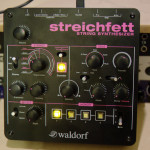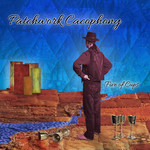Review: Stagg Splash Cymbals
This was originally intended as a review of some Stagg mini-china and splash cymbals, primarily the DH 10″ china and the DH 6″ splash. However, by chance I ended up with a pair of each of these cymbals and to some extent it has now become an article on the variation between cymbals within the same model line.
First up I want to distance myself from a lot of the automatic Stagg-is-cheap-junk views out there. There’s a lot of brand loyalty and get-what-you-pay-for mentality in equipment circles of all sorts, and drummers are no exception. I’m going to cut to the chase here and say that one of the two DH 10″ chinas I bought is fast becoming one of my favourite cymbals, even next to the Sabian AAX, HHX Evolution and Paiste Sound Creation cymbals I’ve got. But in that comment lies the nub of this review: only one of those two supposedly identical chinas is that lovely. The other is completely different and will be going back to the shop.
Tags: cymbals, staggReview: Waldorf Streichfett
 With all of the work sorting out the release of Patchwork Cacophony and doing the refit of the studio it felt like time to have a bit of fun. A month or so back I treated myself to a Waldorf Streichfett string synthesizer and so thought I’d dig in and review it a bit.
With all of the work sorting out the release of Patchwork Cacophony and doing the refit of the studio it felt like time to have a bit of fun. A month or so back I treated myself to a Waldorf Streichfett string synthesizer and so thought I’d dig in and review it a bit.
As a little bit of perspective, I’ve been keen on getting my hands on a string synthesizer for a while. I find that I actually get on much better with instruments with limited but strongly defined characters than I do with sonic chameleons. I’ve often though of string synthesizers as a bit like the 70’s, analog synth equivalent of the hammond organ,.both being essentially additive synthesizers of a source but with one using (sort of) sine waves and the other saw waves with an amplitude envelope.
As recently as a year ago I actually started fiddling with the idea of building a digital/analogue hybrid instrument of my own but time (and skills) were in short supply. Then, as if by magic, along came Waldorf with the Streichfett!
Review: Gear4Music 12 String Electro-Acoustic
One of the things about being a multi-instrumentalist is you end up with an awful lot of instruments and equipment. Leaving aside the question of where you store all of this stuff, the next obvious problem is the cost. While a professional musician might expect to buy an expensive instrument or two if it was the tool of his trade, it gets more difficult to justify and afford when you surround yourself with quite so many tools. As such, I spend quite a lot of time trying to find usable instruments at the budget end of the scale.
Roland Super JX-10 Review
Back in May last year I got hold of a second hand Roland Super JX-10 and its associated programmer, the PG-800.
This was, I understand, the last of Roland’s analogue polysynths, and in particularly the last of the Jupiter line. It has some well-documented weaknesses with its MIDI implementation, not least of all that you can’t store or edit patches via MIDI. As its interface is via a two line menu and selector dials and buttons, the external programmer is considered something of a must-have for anyone seriously interested in programming it or tweaking it in realtime.
Tags: gsrp, jx10, music, review, roland, synthProphet ’08 PE Review
Note: this review is not written from the usual perspective of examining an instrument and comparing knowledgeably it with its peers in the market, it is written more as a personal journey from a very specific viewpoint. If you’re after the former, the review in Sound on Sound is an excellent place to start.
Tags: gsrp, music, prophet, review, synthThe Grand Synthesizer Research Project
I often refer to myself as a Keyboard Player. It’s a convenient shorthand, but closer to the truth would be to say that really, I’m a Hammond organ player and a pianist. I occasionally dabble in other sounds but even then I’m more drawn to electromechanical keyboards (and their emulations) such as the Clavinet, or Wurlitzer and Rhodes electric pianos.
Tags: gsrp, music, synth
